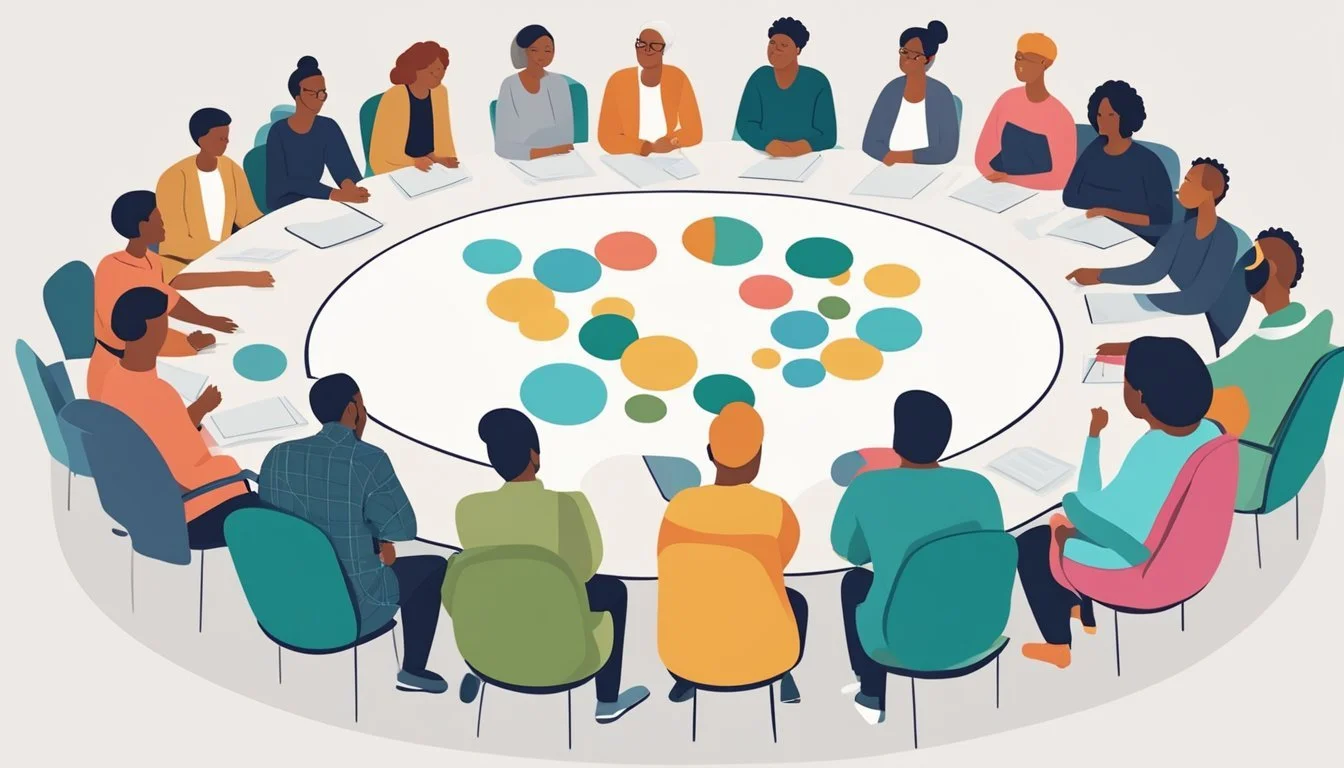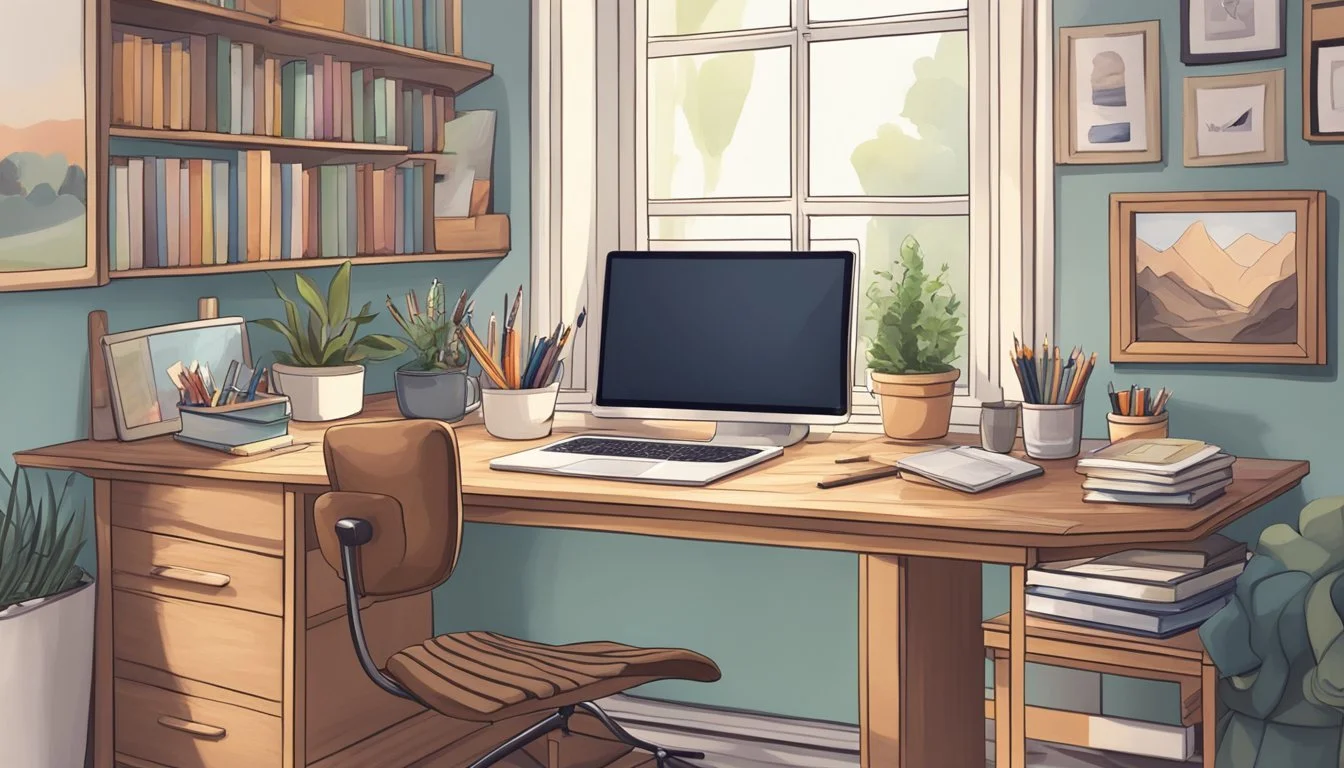12 Strategies for Managing PTSD Symptoms in Creative Fields
Expert Tips for Artists and Writers
Post-Traumatic Stress Disorder (PTSD) can have a profound impact on individuals within creative fields, affecting their ability to work and express themselves. Artists, writers, musicians, and other creative professionals may experience unique challenges when dealing with PTSD symptoms.
Understanding and managing PTSD is crucial for maintaining mental health and professional productivity. This article explores 12 strategies that can help individuals in creative industries manage PTSD symptoms effectively, allowing them to continue their work with greater ease and resilience.
1) Mindfulness Meditation
Mindfulness meditation is increasingly recognized as an effective strategy for managing PTSD symptoms, particularly among those in creative fields. This practice emphasizes staying present and fully engaging with the current moment.
Studies have shown greater trait mindfulness is linked to decreased PTSD symptoms. Creative individuals often benefit from mindfulness as it helps reduce stress and anxiety while enhancing focus and creativity.
In a survey of VA PTSD treatment programs, 96% reported utilizing mindfulness as part of their therapeutic approaches. This high adoption rate underscores the effectiveness of mindfulness practices.
Mindfulness meditation involves techniques like deep breathing, body scans, and mindful movement. These practices can help mitigate intrusive thoughts and emotional dysregulation, which are common symptoms of PTSD.
Scientific reviews indicate that mindfulness-based interventions have a medium effect size on reducing PTSD symptoms. Regular practice can improve emotional regulation, reduce hypervigilance, and promote a sense of inner peace.
In trauma-informed mindfulness, particular care is taken to avoid triggers. This approach ensures that meditation remains a safe and effective tool for individuals coping with PTSD.
For more detailed evidence on the benefits, visit this Psychology Today article or review findings from NCBI studies.
Mindfulness meditation offers a practical, accessible method for managing PTSD, fostering both mental well-being and creative productivity.
2) Expressive Art Therapy
Expressive Art Therapy utilizes various art forms—such as painting, drawing, music, and dance—to help individuals manage and alleviate PTSD symptoms.
This therapeutic approach engages creativity to process traumatic experiences. By creating art, individuals can externalize their trauma and begin to understand it from a different perspective.
Research shows that creative therapies can reduce PTSD symptoms, anxiety, and depression. Activities like painting and sculpting allow participants to depict their trauma and view it from a safe, physical distance.
Expressive Art Therapy is particularly effective for those who struggle with traditional talk therapy. This method provides a non-verbal way to express complex emotions.
Studies indicate that incorporating expressive arts in therapy can enhance the quality of life for PTSD sufferers. For example, visual arts therapies like drawing and painting offer a way to visualize and confront traumatic memories safely.
In a 2016 study, creative arts therapies were also shown to reduce anxiety symptoms in refugee adolescents from Burma experiencing PTSD. Customized activities like music therapy or dance can be tailored to suit individual therapeutic needs.
For further insight, explore how art therapy has been used in treating PTSD effectively.
3) Establish Regular Creative Routines
Implementing regular creative routines can provide stability and predictability, which are valuable for individuals dealing with PTSD. Consistent routines aid in reducing anxiety and establishing a sense of control.
Setting specific times for creative activities, whether it's writing, painting, or any other medium, helps in managing symptoms. This structured approach creates a safe space for self-expression.
Incorporating these routines into a daily schedule ensures that creativity remains a consistent and reassuring part of life. This schedule can be as simple as dedicating an hour each morning to a creative practice.
Regular creative routines not only help in symptom management but also foster continuous personal growth and development in creative skills. This advancement can boost self-esteem and provide a sense of accomplishment.
By firmly establishing a creative routine, individuals can create a supportive environment that enhances their overall well-being. More information on these benefits can be found in articles such as Coping with PTSD: Strategies for Managing Symptoms.
4) Incorporate Physical Exercise
Physical exercise can significantly help individuals in creative fields manage PTSD symptoms. Regular exercise has been shown to reduce stress and improve mood by promoting the release of endorphins. These neurotransmitters help alleviate depression and anxiety, making it a valuable tool in PTSD therapy.
Cardiovascular exercises such as running, cycling, swimming, or brisk walking are highly beneficial. They not only enhance physical fitness but also aid in stress reduction. Incorporating these activities regularly can improve overall mental well-being and boost self-esteem.
Another effective approach is to include adaptive fitness strategies tailored to individual needs. This type of exercise can address specific physical limitations and provide a customized way to stay active. Adaptive fitness can be particularly beneficial for those struggling to find a suitable exercise routine.
Art therapy combined with physical activity also shows promise. Engaging in creative processes while maintaining physical movement allows for emotional expression and greater self-awareness. This dual approach can offer a holistic way to manage PTSD symptoms effectively.
Engaging in group exercises can provide social support and create a sense of community. Sharing physical activities with others can make the exercise routine more enjoyable and contribute to a feeling of connectedness and belonging.
By incorporating these various physical exercises, individuals can create a balanced strategy to manage and alleviate PTSD symptoms effectively.
5) Join Support Groups
Support groups can be a significant resource for those managing PTSD symptoms in creative fields.
These groups offer a platform where individuals can share their experiences, challenges, and coping mechanisms with others who understand their struggles.
Engaging with a support group provides emotional backing and can help reduce feelings of isolation.
Participants can discover new coping strategies that may not have been previously considered. Many find that hearing about others' approaches to managing symptoms can inspire new ideas for their own journeys.
There are various types of support groups available. Some might focus on specific industries, such as those for creative professionals, while others are more general.
You can find support groups through community mental health centers or by consulting with a primary care doctor or therapist. Additionally, online options are accessible through social media or websites that list mental health resources.
Being part of a support group fosters a sense of community and belonging. It can also lead to valuable connections and friendships with others navigating similar challenges. For available groups, check resources like PTSD support or Mind Diagnostics.
Support groups are a practical and often effective strategy to help manage PTSD symptoms while navigating creative careers.
6) Cognitive Behavioral Therapy (CBT)
Cognitive Behavioral Therapy (CBT) for PTSD focuses on changing the relationship between thoughts, feelings, and behaviors. By addressing unhelpful thinking patterns, individuals can achieve healthier behaviors and improved emotional regulation.
CBT targets current problems and symptoms, making it a practical choice for those needing immediate relief. Typically, it involves short-term, weekly sessions lasting about 50 minutes, over 12-20 weeks.
Research has shown that CBT is effective in reducing PTSD symptoms. It can also alleviate depression and anxiety, which often accompany PTSD. For instance, a systematic review in 2021 confirmed its efficacy in symptom reduction.
A CBT therapist helps patients understand their underlying thought processes and emotional reactions to trauma. This understanding can reduce the severity of panic and other adverse reactions. More details about how the process works are available on Choosing Therapy.
Patients learn coping strategies that they can apply in various situations, promoting long-term recovery. This therapeutic approach is widely recognized and utilized in managing PTSD symptoms, offering a structured pathway to healing. For more information, visit the APA.
7) Set Achievable Goals
Setting achievable goals is essential for managing PTSD symptoms, especially in demanding creative fields. The SMART goal framework, which stands for Specific, Measurable, Achievable, Relevant, and Time-based, can be particularly effective. This structure helps individuals create clear and actionable objectives that can significantly reduce feelings of overwhelm.
By establishing precise and attainable targets, creative professionals can maintain focus and motivation. For instance, a goal could be to improve sleep hygiene within a month by following a consistent bedtime routine. This approach can enhance both mental well-being and overall productivity.
Achievable goals should be pertinent to the individual's specific challenges and aligned with their creative pursuits. For example, setting a goal to increase physical activity might help alleviate PTSD symptoms and boost energy levels, making it easier to engage in creative tasks.
Using tools like goal-setting worksheets can provide additional clarity and structure. Worksheets can guide individuals in breaking down larger aspirations into manageable steps, making the process less daunting. These structured goals can help build confidence and a sense of accomplishment over time.
For more detailed guidance on setting meaningful PTSD treatment goals, consider resources like this step-by-step guide to setting meaningful PTSD treatment goals. This resource offers practical advice on creating goals that address symptom management and improve daily functioning.
8) Journaling
Journaling can be an effective tool for managing PTSD symptoms. Expressive writing helps individuals process emotions, leading to reduced anxiety and anger. This practice also decreases body tension and enhances focus.
Writing about triggers allows for better identification and understanding of negative thought patterns. Exploring emotions tied to past trauma can foster emotional release and healing.
Structured approaches to journaling, such as using prompts, sentence stems, and list-making techniques, provide a solid foundation for recovery. These methods guide the writing process, making it more purposeful and therapeutic.
Incorporating daily journaling into one's routine aids in tracking progress and recognizing patterns. Consistency is key to harnessing the full benefits of this practice. For those unsure where to start, prompts can be a helpful guide.
Journaling offers the potential for post-traumatic growth, not just post-traumatic stress. By openly expressing thoughts and feelings, individuals can find new strengths and perspectives. The act of writing itself can be a cathartic and empowering experience.
For more information on the benefits and methods of journaling for PTSD, visit How to Use Journaling to Cope with PTSD.
9) Practice Deep Breathing Exercises
Deep breathing exercises can be one of the most effective ways to manage PTSD symptoms. These exercises help calm the nervous system and promote relaxation, making them highly beneficial for individuals in creative fields.
To practice, sit or lie down in a comfortable position. Inhale slowly through the nose to a count of five, expanding the abdomen rather than the chest. This format ensures a deep and full breath.
Hold the breath for a few seconds, then exhale slowly through either the nose or mouth, counting to seven. Repeating this process several times can reduce anxiety and provide a sense of calm.
Incorporating a soothing word or phrase during exhalation, such as "calm," can enhance the relaxing effects. Consistent practice increases effectiveness over time, helping individuals manage stress more efficiently.
Studies have shown that regular deep breathing exercises can result in decreased levels of stress and anxiety by influencing the autonomic nervous system. Resources like the National Center for PTSD provide guided exercises for those interested.
For more detailed techniques, websites like Wellness Drip and Positive Psychology offer comprehensive guidance. These resources can be valuable for individuals looking to implement deep breathing practices into their daily routines.
10) Limit Exposure to Triggers
Limiting exposure to PTSD triggers is essential for maintaining emotional stability. Identifying common triggers can help an individual anticipate and avoid situations that might cause distress.
Setting up a safe space at work or home can provide a refuge from external stressors. This space should be tranquil and free of any elements that might evoke traumatic memories.
Strategically managing social interactions is another key approach. This may involve steering clear of certain people or environments that are known to be triggering.
Technology can also play a role. Using apps or tools that block specific content helps minimize unintentional exposure to distressing material.
If professional situations require unavoidable engagement with potential triggers, planning ahead with coping techniques can be beneficial. For instance, mental health professionals at 12 South Recovery offer guidance on managing these moments.
11) Seek Professional Help
Engaging the expertise of a mental health professional can significantly aid in managing PTSD symptoms. Professionals such as psychologists, psychiatrists, or licensed clinical social workers are trained to provide effective treatment.
Therapies like cognitive-behavioral therapy (CBT) and eye movement desensitization and reprocessing (EMDR) have shown success. These therapies help individuals process traumatic experiences and reduce symptoms.
Medications can also be beneficial for some symptoms like depression, anxiety, and sleep disturbances. Consulting with a psychiatrist can help determine the right medication and dosage.
Building a strong support system is crucial. Family members and friends can be encouraged to learn about PTSD, fostering a healthier and more supportive environment at home.
12) Use Music as a Therapeutic Tool
Music therapy has shown promise in alleviating symptoms of PTSD. Studies reveal that music can positively impact socio-emotional development, aiding in socialization and personal growth. It offers a nonverbal outlet for expression, which can be especially useful for those struggling to articulate their trauma.
Individuals can engage with music therapy in various ways, such as passive listening or active involvement like singing or playing instruments. Research suggests that these activities can help stabilize mood, reduce anxiety, and foster a sense of control and safety.
Music has been studied as an intervention for several conditions, including PTSD. Clinical trials and systematic reviews have concluded that music therapy can significantly improve psychological well-being and overall mood. Due to its therapeutic potential, music intervention has become an area of growing interest among mental health professionals.
Given its non-invasive nature, music therapy can be easily integrated into a comprehensive treatment plan. It provides a flexible approach that can be tailored to individual preferences and needs. Whether used alone or alongside other treatments, music serves as a powerful tool in managing PTSD symptoms effectively. For more in-depth information, you can refer to detailed studies on music interventions for PTSD available here and here.
Understanding PTSD in Creative Fields
PTSD can impact anyone, but creative professionals may face unique challenges that heighten their vulnerability to the disorder. Below is a detailed examination of PTSD and its symptoms, as well as why those in creative professions are particularly prone to it.
Definition and Symptoms of PTSD
Post-Traumatic Stress Disorder (PTSD) is a mental health condition triggered by experiencing or witnessing a traumatic event. Symptoms may include flashbacks, nightmares, severe anxiety, and uncontrollable thoughts about the event.
People with PTSD might also experience emotional numbness, irritability, and sleep disturbances. These symptoms can significantly impair daily functioning and professional performance. Understanding these symptoms is crucial for recognizing and addressing the impacts on creative professionals.
Why Creative Professionals Are Prone to PTSD
Creative professionals such as artists, writers, and filmmakers often immerse themselves deeply in their work. This emotional investment can expose them to mental distress, especially if their work involves heavy or traumatic themes.
The unpredictability of the creative industry, including financial instability and intense competition, adds to their stress. Moreover, many creative roles demand long hours and emotional vulnerability, making it harder to cope with trauma and stress.
Combining these factors creates an environment where PTSD can easily take root and thrive, underscoring the need for effective coping strategies tailored to those in creative fields.
Impact of PTSD on Creativity and Work
PTSD can disrupt both the creative process and workplace functionality. Symptoms like flashbacks, anxiety, and hypervigilance can impede concentration and imaginative output, making it challenging to meet professional demands.
Emotional and Cognitive Effects
PTSD often leads to emotional and cognitive disruptions that can stifle creativity. Individuals may struggle with negative and intrusive thoughts that manifest as nightmares or flashbacks. This kind of internal turmoil hampers their ability to focus on creative tasks. Emotional numbing, another symptom of PTSD, can diminish the emotional depth necessary for artistic expression. Moreover, cognitive impairments such as difficulty concentrating, memory issues, and decision-making challenges can further inhibit creative work. It's not uncommon for those affected to experience a significant drop in their creative output and motivation.
Challenges in Professional Settings
PTSD symptoms can also create substantial challenges in professional settings. Intense and disruptive symptoms like panic attacks or hypervigilance can make it difficult to maintain consistent performance at work. Individuals may find it tough to meet deadlines or engage in collaborative projects, which are often essential in creative fields. The constant battle with these symptoms can lead to absenteeism or decreased productivity. Additionally, workplace environments can sometimes exacerbate these symptoms, making daily tasks feel daunting and unmanageable. This can affect not only the individual's career growth but also their overall job satisfaction and mental well-being.
Building a Support System
Effective management of PTSD symptoms often involves creating a robust support system, which includes both professional help and peer support. These elements provide the necessary structure to navigate the challenges associated with PTSD.
Finding Professional Help
Seeking professional help is a critical step for individuals dealing with PTSD. A licensed therapist or counselor, experienced in trauma and PTSD, can offer evidence-based treatments such as Cognitive Behavioral Therapy (CBT) and Eye Movement Desensitization and Reprocessing (EMDR). These therapies focus on processing traumatic memories and reducing PTSD symptoms.
Medical professionals, including psychiatrists, might prescribe medications to manage symptoms like anxiety and depression. Medications aren't suitable for everyone, but they can provide significant relief. It's essential to discuss all treatment options with a healthcare provider to tailor the approach to individual needs. Engaging with a healthcare team ensures comprehensive care and support.
The Role of Peer Support
Peer support plays an invaluable role in managing PTSD. Connections with others who have similar experiences can provide empathy, validation, and a sense of community. Peer support groups, whether in-person or online, create a safe space to share experiences and coping strategies.
In creative fields, specialized support groups might focus on integrating creative expression into the healing process. This can include art therapy workshops, writing groups, or music therapy sessions. These groups not only help with emotional healing but also encourage the continuation of creative pursuits.
Engaging friends and family in the support network can enhance stability and provide everyday emotional support. Encouraging them to learn about PTSD can foster understanding and reduce stigma. This collective support network is crucial for long-term management and recovery.













